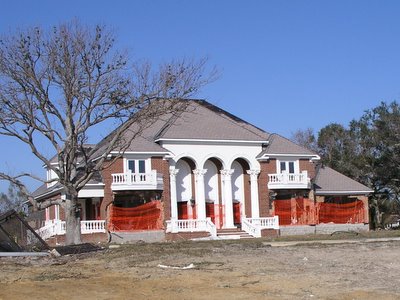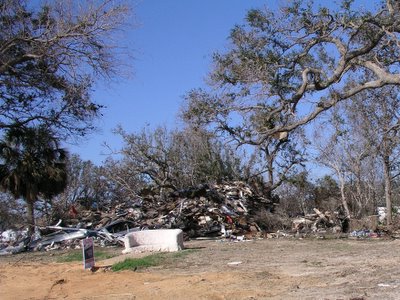 Today, I returned to Pascagoula for the first time since Hurricane Katrina.
Today, I returned to Pascagoula for the first time since Hurricane Katrina.It was a remarkably beautiful January day, even for the Gulf Coast. The sun was shining in a clear blue sky, temps were in the low 70s, the humidity was down, and there was a nice offshore breeze.
We drove along Beach Boulevard, once the prettiest road in town, where I used to jog between the Gulf of Mexico on one side and the town's stateliest homes (including that of Trent Lott) on the other during my summer here.
I was amazed by the devastation. I had been in Grand Cayman the first week it had opened to tourists following Hurricane Ivan, but the destruction on the island was nothing compared to this.
 The homes on Beach Boulevard didn't have a chance. All that had stood between them and the surging Gulf at the height of the storm was the boulevard and a low concrete seawall. The brick houses fared better than the wood homes, a fact that would have made the third little piggie proud. But in either case, one could clearly see that the damage was from water, the storm surge, and not from the wind. The upper levels of the houses were generally intact, but the lower levels had been gutted. In this regard, the effect of the storm was more like last year's tsunami than Hurricane Ivan.
The homes on Beach Boulevard didn't have a chance. All that had stood between them and the surging Gulf at the height of the storm was the boulevard and a low concrete seawall. The brick houses fared better than the wood homes, a fact that would have made the third little piggie proud. But in either case, one could clearly see that the damage was from water, the storm surge, and not from the wind. The upper levels of the houses were generally intact, but the lower levels had been gutted. In this regard, the effect of the storm was more like last year's tsunami than Hurricane Ivan.It's apparent from the remains that the buildings, designed as they were with hurricane-force winds in mind, had withstood the gale. One can only imagine, though, what it must have been like as the sea surged up against the house, the sheer weight of water buckling and then breaking the walls. The sea must have filled whatever structure remained, and then completed the one-two punch as the surge retreated and the walls were further reduced by the force of the exiting water.
 In some cases, the lower portions of the homes were entirely gone, leaving otherwise intact roofs sitting on the ground.
In some cases, the lower portions of the homes were entirely gone, leaving otherwise intact roofs sitting on the ground.  The wooden houses did not fare as well, although the effects were similar. Although the house above now looks like a shack, what is left now is just the uppermost portion of a formerly two-floor shorefront home. The rest is all gone. But rubble and scrap were all that was left of other homes.
The wooden houses did not fare as well, although the effects were similar. Although the house above now looks like a shack, what is left now is just the uppermost portion of a formerly two-floor shorefront home. The rest is all gone. But rubble and scrap were all that was left of other homes. The trees, groomed for millennia to withstand nature's forces, held up pretty well - the water would have surged around, not through, them.
The trees, groomed for millennia to withstand nature's forces, held up pretty well - the water would have surged around, not through, them.After the hurricane and surge had passed, even Trent Lott and his wife, like their neighbors, could only pick through the debris that used to be their home. Across the debris field that was once their backyard, they searched tearfully for anything else they could save. On a sandy patch of ground, they carefully arranged family mementoes - a framed photo, a china serving plate, small brass sculptures.
It's heart-breaking to witness the remains of these ruined homes, and imagine the dashed dreams and aspirations associated with them. What these pictures can't convey is the accumulative visual effect of seeing block after block of buildings destroyed like this, both along the length of Beach Boulevard and for several blocks inland.
I felt vaguely creepy and voyeuristic taking these pictures. "If anyone asks, just say we're insurance adjustors," suggested my passenger, addressing the obvious discomfort, although, up to that moment, we had not spoken of it. Crude hand-letter signs in front of the homes identified the house number and insurance carrier for the benefit of real adjustors and for contractors, and warnings on dead-end streets read "Private Road - Trespassers Will Be Shot."
We avoided the dead-end streets.
After having been shown this vivid evidence of what real suffering is like, I feel shallow and trivial having complained about spending the summer here. A mere weekend after I was complaining that the best restaurant in town was only a Ruby Tuesday's, work crews were driving around picking up bodies left like garbage on sidewalks and depositing them in refrigerated mobile morgues, and coroners were conducting autopsies in parking lots because the only available light was from the sun.
In Pascagoula, 126 people died from Katrina, most of the victims having drowned or suffering severe injuries when buildings collapsed around them. By the time the coroner collected their corpses, their faces had been distorted from the water or the rubble, and they were starting to decompose. Their identification and clothes were swept away, and many bodies had drifted miles from home.
That evening, my waitress, a cute blonde formerly from Tennessee, talked to me about her experiences in Mobile during the storm. She and her daughter were unhurt, but for them the worst part was the next three or four days without electricity or air conditioning. They'd fill a kiddy pool with water and sit in it together until the afternoon sun made the water temperature too uncomfortable to sit in any longer. That was a level of suffering I could better relate too, and I went back to my hotel room after dinner hoping the mental picture I had constructed of them splashing in the pool would scare the 126 ghosts of Pascagoula out of my consciousness.

No comments:
Post a Comment